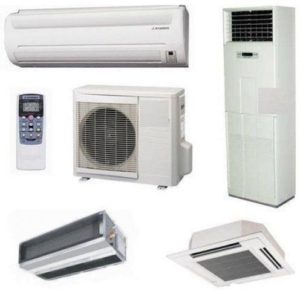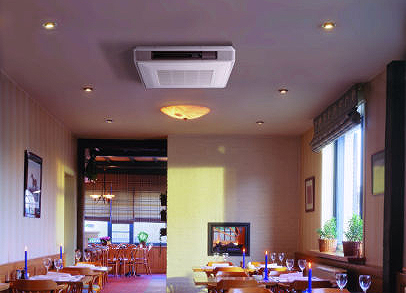 Different types of air conditioners serve one or more rooms. Modern air conditioners perform many functions besides air cooling. The device of the latest generation not only cools, but also filters, ionizes the air in the room, eliminates odors.
Different types of air conditioners serve one or more rooms. Modern air conditioners perform many functions besides air cooling. The device of the latest generation not only cools, but also filters, ionizes the air in the room, eliminates odors.
Specialists distinguish the types of air conditioners for an ordinary apartment and a large trading floor. The difference in technology exists in various respects.
Content
Main types
Modern industry produces equipment for cooling rooms designed for various areas of use. The most popular among the population are household low-power models. In industry, trade, and the service sector, where the premises have a large area, powerful air conditioners are installed that can provide comfortable conditions in a large area.
At the location of the inner case, the equipment is divided into:
- Window.
- Wall mounted.
- Ceiling.
- Floor standing.
The installation location does not say anything about the power of the equipment. The location of the cooler allows the most efficient use of its technical capabilities. Ceiling systems evenly distribute indoor air, floor and window are the easiest to install. Floor air conditioners can be mobile, split column systems.
There is a classification according to the number of work blocks:
- Monoblock.
- Split systems.
- Multi split systems.
By power, the types of air conditioners are classified as follows:
- Window.
- Mobile
- Split systems.
- Multi split systems.
- Cassette
- Columned.
The most correct division according to the third indicator, since any technique is appreciated for its technical capabilities. When buying an air conditioner proceed from these indicators.
Window air coolers
This view is the first among air conditioners. One-piece window devices got the name from the location. Installation is simple: a hole is made in the window to the size of the equipment, inserted into the opening and connected to the network. The main advantage of this type is the ease of installation, maintenance. It is easy to clean, repair. The disadvantages include low power - these are the weakest air conditioners. In addition, they occupy part of the window, which makes the room darker. Another significant drawback is that it needs to be carefully insulated for winter time. It works only for air cooling.
The low cost and ease of installation make such models in demand today. They are inferior in popularity only to split models. New window types of coolers have a more modern design, reduced noise level, which they are so famous for.
Mobile air conditioners
Another representative of the class of monoblock air conditioners is mobile. It is installed on the floor of the room. It got its name from the ability to move equipment depending on the need. The main advantage of this type is the ease of installation. For the operation of such a device, you do not need to cut a window or drill a wall. All mobile air conditioners work with the outlet of hot air to the outside through a flexible hose that fits in the window or doorway.
Mobile air conditioners are equipped with wheels that make it easy to move equipment to the desired place of work. They fit well into the decor of the room, easy to maintain.
These models are notable for their high cost and increased noise level that is created during operation. The disadvantages include the fact that they occupy a place on the floor.
Recently, new types of mobile air conditioners - split systems.They have an outdoor unit that connects to the inner, movable housing using special clips. They do not limit the ability to move the indoor unit.
Split systems
The most popular type of air conditioners is split systems. The basis of their work is the separate operation of the condenser and evaporator. The capacitor is fixed to the outer wall of the building. Using tubes connects to the evaporator, which is located indoors. The air is captured by the evaporator, distilled through pipes through the condenser in which the refrigerant is located. The cooled air is fed back into the room. The advantages of split systems are:
- High power.
- The ability to work on heating the room.
- Option multi system.
- Convenient control using the remote control.
- Does not occupy the useful area of the room (in the wall version).
- Low noise.
- Air filtration.
Separation of functions and the location of one of the blocks outside can significantly increase the power of the system. These are the most technically powerful representatives of this technique.
Monoblock versions of split technology are used for domestic purposes in small offices. Multisystems serve several internal objects.
In this case, the external condenser is one, and in each separate room its own evaporator is installed. Such models are difficult to install, since a connection to each indoor unit is required. In addition, in the event of a malfunction in the outer casing, the entire system fails. The advantages include the presence of 1 outdoor unit. The appearance of the external wall with this type of air conditioner is not very affected. Multi systems require expensive installation.

All split models are equipped with a convenient remote control that allows you to control equipment from a distance. The latest options work in night mode. This option allows you to more efficiently use the power of household appliances. Each of the multi-type internal cases has its own remote control, independent operation mode. Several evaporators in different rooms can work for various functions - cooling in one room and heating the air in another.
New developments of split technology are inverter air conditioners. Thanks to modern developments, it is possible to save up to 30% of electricity, which makes the work of such models more profitable.
All models of split air conditioners have a purification function. Recent developments allow ionizing indoor air, eliminating odors.
Ceiling
Air conditioners that are installed on the ceiling are classified as split models. This is usually a cassette type air conditioner. A big plus of this technique is power. By this indicator, they are second only to columned types of equipment. They are installed in assembly, trading floors with a large area. Air is supplied in 4 directions. In this case, the intensity is regulated in each stream separately. They most evenly distribute air, excluding individual cold flows. To catch a cold, sitting under a cold stream of air from the air conditioner, is not for such a situation.
They are located between the false ceiling and the usual. A variation of the ceiling view is the technique of the channel type. It works with outdoor air, providing flow into the room. Such models serve several rooms, connecting ducts. Like cassette models, they are installed in the opening between the suspended and ordinary ceilings and therefore do not have a fashionable design. This is a technique designed for effective work, not visible to prying eyes. Only a small grille is visible on the ceiling, which does not spoil the appearance of the room.
Duct-type air conditioners can be attributed to multi-ceiling systems, since air is in several rooms at the same time.
A significant drawback of ceiling types of equipment is the necessary presence of a suspended ceiling. In a room where such a ceiling is not installed, it is impossible to count on the operation of ceiling air conditioners.

Column models
The most powerful form of technology. Found its application in large halls of hotels, in production. It is installed on the floor, so the column type can be attributed to floor air conditioners. But, unlike mobile models, they are rigidly fixed in one place. Large blocks take up a lot of space, and installing them in small rooms does not make sense.
The column type air conditioner belongs to split systems, therefore it has an outer casing. The indoor unit looks like a column, hence the name - columned. As a rule, the design of such models was not particularly tricky, relying on great power. Production models are installed in an open space, where the aesthetics of the room does not matter. The halls of hotels or other institutions where design is important hide columned air conditioners behind beautiful screens.
The right choice of equipment depends on each specific case. The most widely used in everyday life is air conditioning split models of wall type. These are powerful, quiet models that do not take up space in the room, do not reduce the illumination of the room. True, they cost more than window options. In addition, when installing this type of equipment you will have to spend money on professional installation.
In offices, channel or cassette-type air conditioning is appropriate. He will easily cope with the task, will not spoil the design of the room.
For rooms with a large area and without special aesthetic requests, the column type is suitable.